JFrame is a composite component, it's actually made up of a number of other components

(From How to Use Root Panes)
So, when you call setBackground, you're only changing the background color of the underlying frame, not the contentPane which resides on it.
Instead, you should be using getContent().setBackground(...).
"But why does setForegound work" I here you ask?
That's because you've overriding paint of JFrame, which is pre-configured with the foreground property of the frame (and not the contentPane)
Now, having said all that...
- You should avoid extending from top level containers like
JFrame, for these types of reasons AND...
- You shouldn't override
paint of them either. You should start with a component, extending from something like JPanel and override it's paintComponent method.
Have a look at:
for things that go wrong when you override paint of top level containers, and also, they aren't double buffered, so updating them causes flickering
Example...
import java.awt.Color;
import java.awt.DisplayMode;
import java.awt.EventQueue;
import java.awt.Font;
import java.awt.FontMetrics;
import java.awt.Graphics;
import java.awt.GraphicsDevice;
import java.awt.GraphicsEnvironment;
import java.awt.Window;
import java.awt.event.ActionEvent;
import java.awt.event.ActionListener;
import javax.swing.JFrame;
import javax.swing.JPanel;
import javax.swing.Timer;
import javax.swing.UIManager;
import javax.swing.UnsupportedLookAndFeelException;
public class Sam extends JFrame {
public static void main(String[] args) {
EventQueue.invokeLater(new Runnable() {
@Override
public void run() {
try {
UIManager.setLookAndFeel(UIManager.getSystemLookAndFeelClassName());
} catch (ClassNotFoundException | InstantiationException | IllegalAccessException | UnsupportedLookAndFeelException ex) {
ex.printStackTrace();
}
DisplayMode dm = new DisplayMode(1920, 1080, 32, 60);
Sam s = new Sam();
s.run(dm);
}
});
}
public Sam() {
add(new MainView());
}
public void run(DisplayMode dm) {
Screen s = new Screen();
s.setFullScreen(dm, this);
Timer timer = new Timer(5000, new ActionListener() {
@Override
public void actionPerformed(ActionEvent e) {
s.restoreScreen();
}
});
timer.start();
}
public class MainView extends JPanel {
public MainView() {
this.setBackground(Color.PINK);
this.setForeground(Color.BLACK);
setFont(new Font("Arial", Font.PLAIN, 24));
}
@Override
protected void paintComponent(Graphics g) {
super.paintComponent(g);
String text = "THIS IS GUNNA BE AWESOME";
FontMetrics fm = g.getFontMetrics();
int x = (getWidth() - fm.stringWidth(text)) / 2;
int y = ((getHeight() - fm.getHeight()) / 2) + fm.getAscent();
g.drawString(text, x, y);
}
}
public class Screen {
private GraphicsDevice vc;
public Screen() {
GraphicsEnvironment env = GraphicsEnvironment.getLocalGraphicsEnvironment();
vc = env.getDefaultScreenDevice();
}
public void setFullScreen(DisplayMode dm, JFrame window) {
window.setUndecorated(true);
window.setResizable(false);
vc.setFullScreenWindow(window);
if (dm != null && vc.isDisplayChangeSupported()) {
try {
vc.setDisplayMode(dm);
} catch (Exception ex) {
ex.printStackTrace();
}
}
}
public Window getFullScreenWindow() {
return vc.getFullScreenWindow();
}
public void restoreScreen() {
Window w = vc.getFullScreenWindow();
if (w != null) {
w.dispose();
}
vc.setFullScreenWindow(null);
}
}
}
